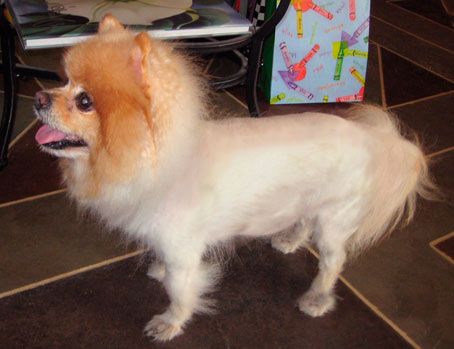Image Quiz: Polyuria in a Pomeranian with a history of hair cycle arrest (Sponsored by Dechra)
What is causing this dog's clinical signs?
Indi, an 8-year-old spayed female Pomeranian weighing 4.6 kg (10.1 lb), is presented for increased urination during the past 6 to 8 weeks. The dog voids large amounts of urine and urinates in her crate overnight. She is drinking substantially more water than before. Indi's appetite and energy levels are good, and her weight is stable. She had failed to regrow hair on her trunk following grooming 18 months earlier and was diagnosed with hair cycle arrest (alopecia X) by a veterinary dermatologist. Results of routine labwork (complete blood count and serum chemistry profile) were essentially unremarkable at that time. Therapy with oral melatonin was unhelpful and was discontinued after 6 months.

On physical examination, Indi is bright and alert. She has bilaterally symmetric truncal alopecia (pictured above) and mild hepatomegaly. Thoracic auscultation is unremarkable, and no abnormalities are noted on fundic and rectal examinations.
Urine specific gravity is 1.006, with a pH of 7 and 1+ protein; culture is negative. A complete blood count shows a stress leukogram with a hematocrit of 56% (reference range = 34% to 52%) and adequate platelets. The abnormal results of a full serum chemistry profile include hypercholesterolemia (366 mg/dl; reference range = 120 to 247 mg/dl), elevated alanine transaminase activity (422 U/L; reference range = 10 to 130 U/L), elevated alkaline phosphatase activity (8,994 U/L; reference range = 24-147 U/L), and elevated gamma-glutamyltransferase activity (240 U/L; reference range = 0 to 25 U/L).
A low-dose dexamethasone (0.01 mg/kg) suppression test is performed, and the results are as follows:
Sample time
Result
Reference range
0 hours
3.4 µg/dl
Not applicable
4 hours
1.1 µg/dl
< 1.4 µg/dl
8 hours
2.7 µg/dl
< 1.4 µg/dl
Which of these recommendations is most appropriate for this patient?
c) Begin therapy with oral lignans and a melatonin implant.
d) Begin therapy with trilostane (Vetoryl®- Dechra).
